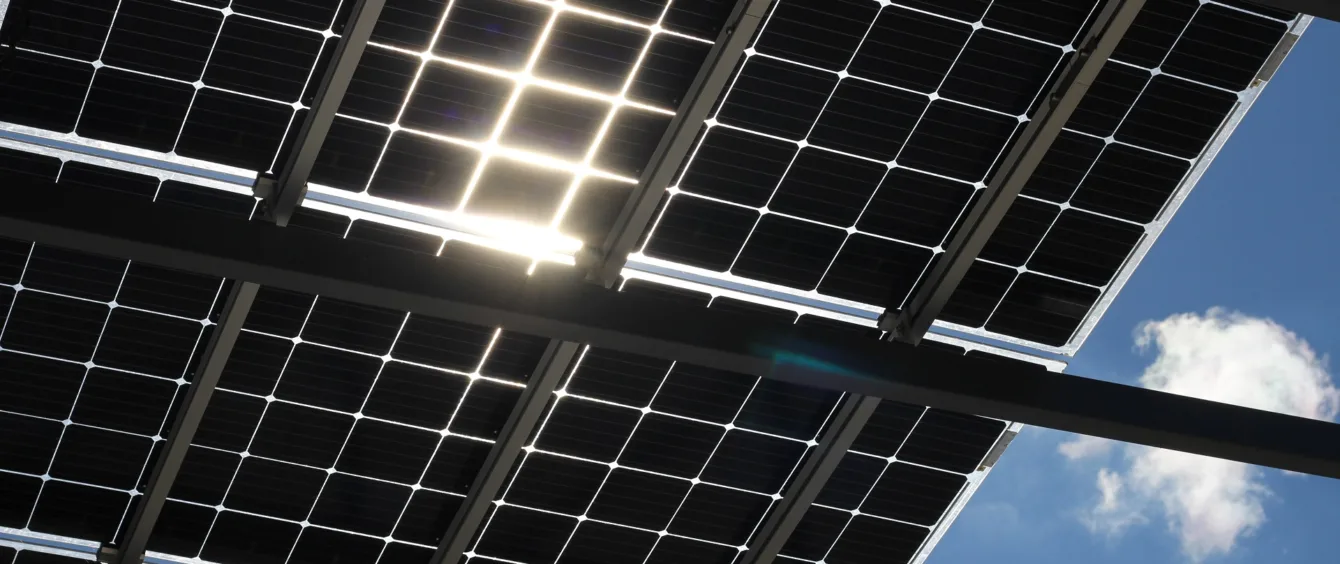Efficiency gains of up to 30 percent without taking up additional space is the potential harboured by bifacial solar panels over their conventional variants. These modules can convert sunlight incident on the front as well as solar rays reflected from the ground to the back. This technology is already in use in numerous systems and possesses huge potential, which is why it is being explored in depth. The en:former presents new promising approaches taken by the sphere of research and development.
Bifacial solar modules feature a simple basic design. A transparent layer is applied not to one, but both sides – e.g. a sheet of glass or a transparent plastic film – through which light impinges on the PV cells in the middle of the module. This enables solar radiation reflected back up from the ground to be used as well. However, the amount of additional electricity generated by such modules depends on a variety of factors including the type of PV cell, the place of deployment, module orientation, and the ground’s reflective performance.
Thin-film cells: practical, but less efficient
To date, bifacial modules have mostly been manufactured from thick-film solar cells incorporating silicon as a semiconductor. Compared to cells made of other materials, these are more efficient, meaning they produce more electric power. Silicon has been a tried-and-tested semiconductor in solar cells thus far, because silicon-based cells are more efficient than variants using other materials, enabling them to generate more electricity from sunlight.
An alternative to thick-film cells are thin-film cells. The benefits of the latter are that they reduce the material requirement for production while being lighter and flexible, enabling them to be used in more applications. However, so far, they have been less efficient than their thick counterparts. Cells made of copper-indium-gallium-diselenide (CIGS) are currently the most efficient. CIGS modules can even achieve higher solar yields than silicon-based cells above all in diffuse light in the morning, evening and winter.
This is why CIGS cells are a particularly appealing proposition when it comes to manufacturing bifacial thin-film solar modules. The objective is to attain thin, lightweight, flexible modules with a high efficiency even when used in bifacial designs. However, the math hasn’t translated into a real-life advantage so far. Even in bifacial modules, CIGS cells have remained fairly inefficient. Scientists of the interdisciplinary research institute of material science and technology, Empa, at ETH Zurich University discovered that the root cause lies in production.
Bifacial CIGS PV cells experience breakthrough
Bifacial CIGS solar cells are usually manufactured at very high temperatures. But this triggers an undesired chemical reaction at the rear contact, which curtails current flows later on. In turn, this decreases efficiency. Therefore, the researchers developed a method of manufacture that works at lower temperatures. By adding a pinch of silver to the CIGS alloy, they were able to reduce the melting point of the semiconductor material. This prevents the chemical reaction at the rear contact.
Now the cells are much more powerful. Instead of the former efficiency ratings of nine and just over seven percent for the front and rear sides, they now convert 19.8 and 10.9 percent of the sunlight to electricity. The cell’s bifacial design thus delivers the desired efficiency enhancement.
Potential not yet exhausted
PV cell efficiency can also be increased with tandem solar cells. This involves placing two PV cells made of different semiconductor materials on top of each other. These solar cells are especially efficient as each semiconductor absorbs a specific spectrum of the sunlight.
Semiconductors made of perovskite are considered to be promising. This explains why the Empa research team mated a CIGS cell with a perovskite cell to form a bifacial tandem solar cell. Although perovskite cell lifetimes are still short, further research may soon come up with a solution to this, too. Ayodhya N. Tiwari, Director of the Empa Thin-Film Technology and Photovoltaic Laboratory at ETH Zurich, predicts efficiencies in excess of 33 percent for CIGS-perovskite tandem cells, which would open the door to many new applications for bifacial thin-film solar cells.
Perovskite semiconductors are considered a promising material for the next generation of solar cells. Similar to thin-film solar cells, PV cells made of perovskite are easy and cheap to produce. In addition, they stand out thanks to their high efficiency, which exceeds the potential of silicon cells. This is why tandem solar cells featuring perovskite are also being explored.
In April 2022, scientists at the University of Wuppertal showcased a new tandem solar cell, which they claim has an efficiency 24 percent, eclipsing the previous record. The tandem was manufactured with both organic materials as well as perovskite semiconductors.
Reflective ground coverings increase solar yields
The solar yields of bifacial modules depend to a great extent on the degree to which the surface on which they are mounted reflects sunlight. The higher the ground reflectiveness (referred to as ‘albedo’) the more light hits the rear side of the solar cells, driving up electricity yield.
This is why deploying this technology is particularly worthwhile in areas where the ground has a high albedo. For instance, research is being conducted on plants with a high albedo. Another promising candidate is white pebbles. Moreover, a number of companies is exploring the possibility of laying bright, UV-reflective films under the solar modules.
